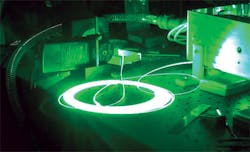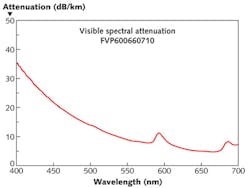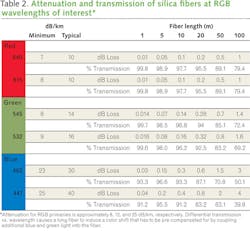Novel Optical Fiber Applications: Fiber-delivered laser lighting: cinema, multi-projector displays, and specialty lighting
BILL BECK
Medical and industrial laser markets have been exploiting optical fiber delivery for more than 20 years, with power levels in the welding segment now approaching 100 kW per beamline. However, these lasers are customized, manufactured in low volumes, and very expensive. Relatively little has been invested in high power visible (RGB) lasers for lighting applications. High wall-plug efficiency (WPE) and long lifetimes have made LED the lighting technology of choice for most general lighting and display applications. However, there are emerging needs for which the unique attributes of RGB laser illumination, combined with optical fiber delivery will enable a new class of solid-state lighting.
The first of these is digital cinema. More than 120,000 movie screens now use standardized, digital cinema projectors that show movies from encrypted data files instead of 35-mm film. This conversion to digital was an operational advance for the industry but with a notable technological irony. These state-of-the-art digital projectors still use 60-year old technology-hand—blown xenon arc lamps—as their light source. Now that the conversion is nearly complete, major projector OEMs and premium cinema integrators are considering laser-illuminated cinema projection as their next technological advancement.
This year will see the first commercial deployments of laser-illuminated projectors from three of the four cinema-projector OEMs: Barco, Christie, and NEC. Systems from Christie and NEC utilize optical fiber delivery. At this early stage, exhibitors are purchasing the technology for trials and promotional purposes, not to save operating expense. But as components and designs mature and production volume builds, RGB laser engines will be deployed in tens of thousands of cinemas. Lasers will replace xenon arc lamps in movie projectors for the same reasons LEDs are replacing traditional lighting—long lifetime and higher wall-plug efficiency. But lasers have additional advantages in that they produce ultra-high spatial brightness, i.e., small optical étendue (mm2-steradian). Lasers deliver all their power from a very small spot in a nearly collimated beam. This unique optical property enables key capabilities for cinema and ultimately for new kinds of specialty solid-state lighting: the ability to input nearly unlimited amounts of RGB light into digital projectors and the ability to deliver kilowatts of visible light via efficient, flexible optical fiber cables (see Fig. 1).
The first benefit solves a number of current cinema challenges, such as increasing 3D brightness and lighting giant screens. Fiber delivery will enable new projection and lighting capabilities and applications.
Gateway to large new markets
Digital cinema is the first, high-volume, standards-driven application for high power RGB lasers, offering a new market opportunity to suppliers able to develop high volume, cost-effective solutions. Minimum system requirements can be summarized as follows:
- Combined RGB power level ranging from 50 to 1000 optical Watts
- greater than 20% E to O efficiency at the color module level
- Lifetime greater than 25,000 hours at less than 20% roll-off
- Independently controllable RGB balance
- High spatial brightness; very good beam quality with no laser speckle
These requirements have been substantially met by first generation commercial systems, but there is more work to be done before the entire cinema market can be converted to laser and additional markets addressed.
For example, extremely large screens and domes—called "giant screen" applications—require two or more projectors per screen. Applications such as the original IMAX 70-mm film theaters must use two projectors per screen, to provide more than twice the brightness of the largest xenon digital projectors and support 3D operation. Ultra-high-power RGB laser illumination, delivered via optical fiber, provides a solution to achieve requisite brightness through a digital projector.
Similarly, many theme park attractions must deploy two or more projectors to create high-resolution, virtual reality-like experiences and achieve required brightness. Disney's popular Soarin' attraction, for example, depends on xenon illumination for its breathtaking but visibly dim vistas of California landscapes. Newer rides such as Universal's Transformers 3D have deployed dual digital projectors in more dynamic and complex ways, but they too suffer from the low 3D brightness of underpowered xenon lamp projection on large screens. Flexible fiber delivery from a centralized source is the key to significant increases in brightness, practical multi-projector designs, reduced power consumption, and the elimination of very costly lamp changes.
Why optical fiber delivery?
Both of these examples highlight the requirements of high performance, multi-projector applications. Maximum-brightness xenon projectors, at about 30,000 lumens, are also the largest, hottest, and noisiest projectors. Putting 2, 4, 6, or more of them close to each other, the show and the audience, whether in theme park attractions, dome theaters, virtual reality caves or jumbo digital signage displays is either operationally impossible or prohibitively expensive. Heroic approaches to local heat extraction and noise abatement have been tried, but fiber-delivered RGB lasers elegantly solve the problem.
The enabling solution for large scale, multi-projector applications, is called off-board illumination (OBI) or fiber-delivered lighting (FDL). Laser light, delivered via fiber, allows a projector and its light source to be independent, separable subsystems. This newly practical remote light delivery concept will stimulate the demand for even higher power RGB lasers for centralized light farm utilities. At that point, fiber delivered solid-state lighting will become practical for large new markets.Fiber-delivered lighting
There are already examples of fiber-delivered lighting in the field. Shipboard systems on some U.S. Navy vessels currently employ metal halide lamps as the light source (see Fig. 2). These lamp-based systems illustrate the opportunity for efficient, cost-effective, high power RGB lasers for remote source lighting (see Table 1).
High spatial brightness enables high power and efficient coupling. The beam quality and coupling system of the laser engine determine the type, size, NA, and number of fibers needed for a given system. Initial cinema prototypes were built with low power devices, often with poor beam quality. This required the use of numerous large-core, high-NA fibers. As higher power, better beam quality RGB lasers become available, efficiency will improve and cable costs will come down.
For the moment, cinema and multi-projector applications are being deployed with one RGB engine per projector. However, as the benefits of FDL drive demand, new centralized light utilities will evolve. Racks of high power red, green, and blue color modules, supported by industrial-scale power supplies, cooling and 1:n protection, will supply multiple projector heads or laser luminaires. This is the long-term direction of fiber-delivered RGB lasers: creating a new class of solid-state lighting.
Remaining challenges
Industry may still be a long way from cost-effective laser lighting for large markets, but the pending commercialization of and high unit volumes required for laser-illuminated cinema, giant screen, and theme park attractions will set the stage for the emergence of fiber-delivered lighting.
The remaining challenges are: 1) steady and continuous cost reduction; 2) development of high-power infrastructure hardware such as cables, connectors, switches, and routers; and 3) the requisite design features including sensors and components to ensure product safety. The most urgent and highly specialized applications will emerge first and then, within 3 to 5 years, centralized laser light utilities and controllable "light-delivery appliances" attached to the ends of safe and cost-effective optical fiber delivery cables could be in widespread use.
Bill Beck is the president of BTM Consulting, Hudson, NY; [email protected].




